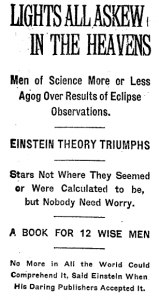Sir Joseph Thomson, O.M., P.R.S., opened the joint session of the Royal Astronomical Society and the Royal Society. He then called Sir Frank Dyson, royal astronomer, to provide the assembly with a complete description of the results of the expedition to last May’s eclipse:
Frank Dyson approached, and in a long statement explained how the idea began and how the expeditions were organized, and then presented a summary of the results: “The effect of the gravitational curvature predicted for a ray of light is to move the star away. ” When measuring the positions of stars in a photograph to test for this displacement, immediate difficulties arise over the scale of the photograph. Scale determination largely depends on the outer stars of the plate, while the Einstein effect causes its largest discrepancy on the inner stars nearer the Sun, so it is quite possible to discriminate between the two causes that affect the position of the star.”
After a very long exposure by the Astronomer Royal, which included all the details of the results of the displacements observed in the positions of the stars detected in both the Sobral and Principe, it was Crommelin and Eddington’s turn to testify. Eddington, in particular, took the opportunity to discuss the curvature of space that was at the origin of the verified deflections, which made it possible to prove the value of the deflection predicted by Einstein, and not the one that predicted by Newton’s theory. According to Eddington: “the simplest interpretation of the bending of the ray is to consider it as an effect of the weight of light. Gravity in acting creates momentum in a direction different to that of the path of the ray and so causes it to bend.”
Text by Ana Simões e Paulo Crawford
Picture: @ Wikipedia
back

